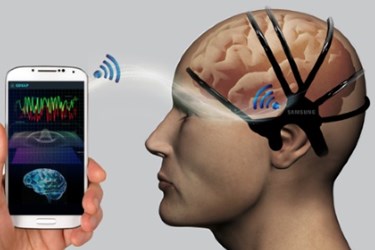Samsung Designs Wearable Stroke-Detecting Device

Samsung has developed a prototype of a wearable device that can track brainwaves and alert the user of the very earliest signs of an impending stroke. The device is designed to be compatible with mobile devices and is capable of analyzing a number of neurological health markers.
Samsung is calling the early prototype of the device the Early Detection Sensor & Algorithm Package (EDSAP), and the project has been in development for the past two years, reports CNET Magazine.
The EDSAP comprises two elements. The first component is a headset made from a flexible, rubber-like material that is fitted with sensors. Those sensors are capable of measuring brainwaves using an advanced algorithm. The algorithm is based on stroke patient brainwave data and a range of artificial intelligence software.
For the second component, the Samsung engineers and software specialists designed a mobile app that can analyze the data in under a minute.
Existing brainwave scanners require fifteen minutes or more to take a reading and often require a saline solution to be rubbed through the hair. EDSAP, by comparison, is much quicker and more user-friendly. Engineers speculate that the material is suitable for a number of wearable versions. In theory, the technology could be integrated into eyeglasses or hairpins rather than a headset.
Se-hoon Lim, the project leader, told Samsung Tomorrow that the project was initially met with a considerable amount of skepticism because brainwaves are so faint and difficult to detect.
“[The development team] approached neurologists, asking them whether this was feasible,” Lim explained, according to Samsung Tomorrow. “They were dismissive, but we wanted to give it a go. Health-related wearable devices are becoming more and more complex, meaning their capabilities are growing increasingly sophisticated. The five of us wanted to make our mark in this development.”
In addition to stroke-predicting data, the device is also capable of tracking sleep patterns, stress levels, and other neurological markers. The device might also have a cardiovascular indication.
“EDSAP has proven it can more than handle brainwaves, and we’ve seen EDSAP’s potential role in addressing other neurological problems,” Lim added in the Samsung Tomorrow article. “We’re now also looking at what EDSAP can do with the heart. Over the next few months, we’ll get a clearer idea of how far the tentacles of EDSAP can reach.”
Seung-Bong Hong, a neurologist at Samsung Medical Center in Seoul, speculated to Samsung Tomorrow about the broader potential of the project and its importance in the medical community. “We believe that EDSAP’s utility can be expanded and applied to other neurological health issues, such as depression.”
According to the CDC, stroke is the cause of death for 130,000 Americans each year and is the leading cause of long-term disability. The CDC estimates that the total healthcare costs of stroke care, medications, and resulting disability accumulate to $36.5 billion per year.
To offset some of the more catastrophic outcomes of strokes, the developers of EDSAP hope that their device can be further developed to assist with the early detection of the condition. However, the device will have to undergo substantial clinical testing before the technology is available to the public.
Image Credit: Samsung Tomorrow
